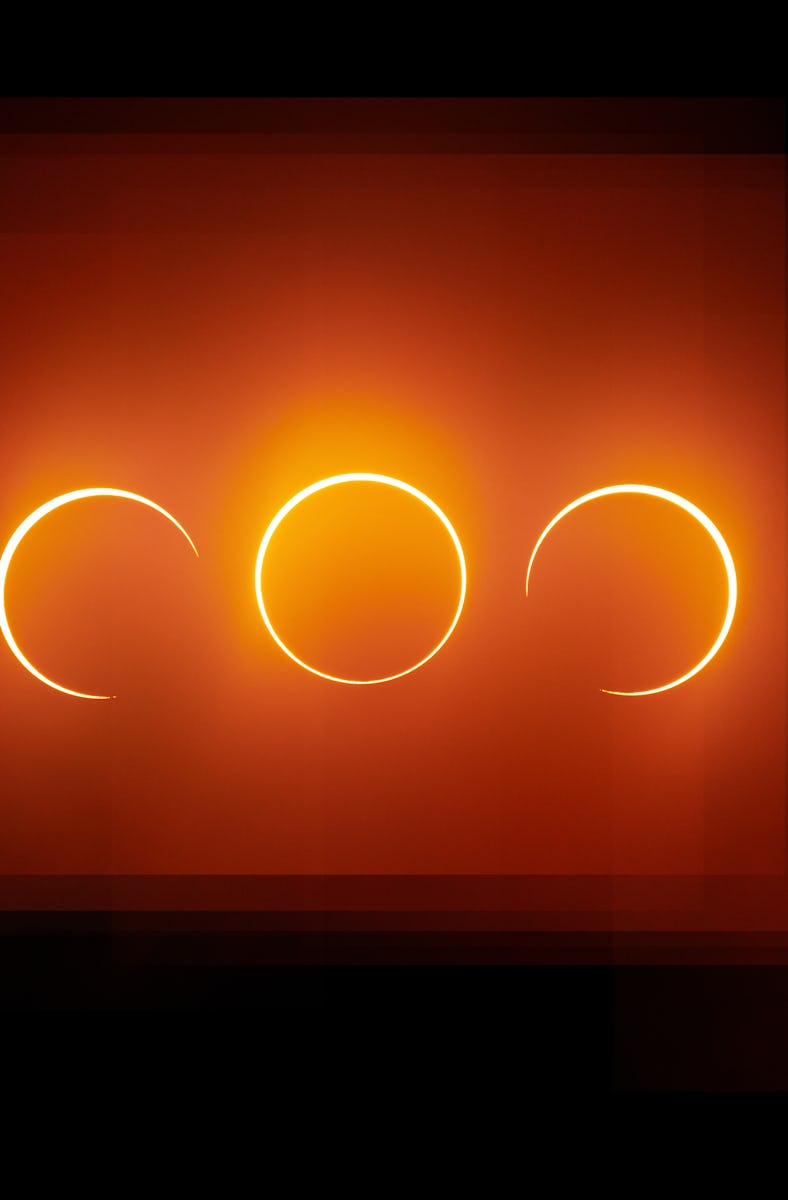How to Watch the 2023 Annular Eclipse This Weekend
Here's your handy Inverse eclipse-viewing guide. Please don't fry your retinas.

The sun will turn into a brilliant ring of fire for a few minutes on Saturday, October 14 — if you’re standing in the right spot, at least.
People across much of North America will get to see at least a partial eclipse on Saturday, and the lucky people along one swath of the western U.S. will get to see an annular eclipse, when the Moon blocks all but a bright ring of sunlight. Inverse has everything you need to know about the annular eclipse, when and where to see it, and how to watch it safely.
What is an Annular Eclipse?
Saturday’s big event is a special type of solar eclipse called an annular eclipse, or a ring of fire eclipse. Solar eclipses happen when the Moon passes directly between the Earth and the Sun, so the Moon blocks the Sun’s light and casts a dark shadow over part of the Earth. But this time, the Moon is at the farthest point in its orbit from Earth, about 253,000 miles away, which makes it look slightly smaller than usual (basically the opposite of a Supermoon.) So when the Moon passes between us and the Sun, it won’t cause a total eclipse; instead, it will leave a bright ring with a dark shadow in the middle.
Here’s a map showing the path of the eclipse; NASA’s interactive map has more details and good information on timing.
Where Can I See the Ring of Fire Eclipse?
Eclipses are a neat trick of objects in space lining up exactly right, and that means that each eclipse is only visible along the long, narrow path that happens to align with the Sun and Moon’s positions. Saturday’s annular eclipse will look like a proper ring of fire only to people standing in a 125-mile wide swath that cuts across the western U.S. and extends through Central America and across Brazil.
People for several hundred miles outside that zone can still see a partial eclipse, which will look like something is slowly taking a big bite out of the Sun. It’s not quite as cool as an annular eclipse, but it’s still well worth stepping outside for a look. Even a partial eclipse is something you don’t see often.
Check NASA’s handy interactive map to find out what the eclipse will look like, and when it will happen, in your area. Inverse suggests:
If you’re in the dark gray shadowed area that gets to see the ring of fire, click “antumbra” from the “Shadows and Cities” menu. Drag the time bar across the bottom of the map until the orange oval reaches your city, then check the time in the lower left corner. Plan to be outside with a good view of the sky a few minutes before the big event.
If you’re outside the narrow lane of the annular eclipse, play with the “partial coverage” options until you get a pair of orange lines that include your location. Then click “penumbra” from the “Shadows and Cities” menu. Drag the time bar across the bottom of the map until the orange shadow reaches your city, then check the time in the lower left corner. Plan to be outside with a good view of the sky a few minutes before the big event.
If you’re outside the area of the eclipse, or if the weather doesn’t cooperate, you can also tune into NASA’s livestreams of the event starting at 11:30 a.m. Eastern Time.
How Not to Fry Your Retinas
An Indonesian astronomer observes hybrid solar eclipse using a solar telescope on April 20, 2023 in Surabaya, Indonesia. You need a special filter for your telescopes, cameras, or binoculars if you’re going to point them directly at the Sun, otherwise your optics may not survive the experience.
Please, for the love of cute animals and all things science, do not look directly at the Sun during the annular eclipse (or ever). Staring directly into the Sun will do serious damage to your retinas, and you’re definitely going to need those later. Yes, even if you’re the president. We are very serious about this.
If you want to watch the eclipse with your own eyes, you’ll need a pair of eclipse glasses or a handheld solar viewer; both of these items use a filter that’s about 100,000 times darker than normal sunglasses. Regular sunglasses will not protect your eyes if you look directly at the Sun. With the eclipse coming, your chances of finding eclipse glasses at your local grocery store or drugstore are pretty decent, or you can order a set online. The Planetary Society has some helpful tips for making sure you’re buying the right eclipse glasses.
Don’t point your camera, telescope, or binoculars at the eclipse unless you’ve got a special solar filter fitted over the lens. Just wearing your eclipse glasses to look through the eyepiece won’t save you. According to NASA, “the concentrated solar rays will burn through the filter and cause serious eye injury.” Please don’t go there.